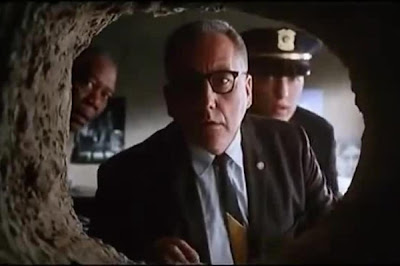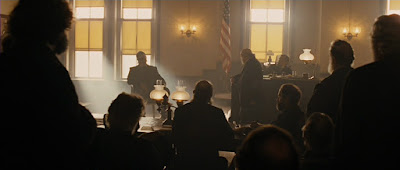Not too long ago, I stumbled upon an article on one of my favorite film production websites, RedShark News, penned by my favorite contributor, Phil Rhodes. It was about the BBC mini-series titled The Luminaries—a period drama about the New Zealand gold rush starring Eva Green and Himesh Patel. However, instead of discussing the show itself, the article used it as the most recent example of a new aspect of filmmaking that many people, including myself, are getting sick of—that being cinematography that is too dark and mumbled incredibly inaudible dialogue. If you would like to read the whole article, I will provide a link to it at the end of this essay. While both of these issues are important and must be addressed, I would like to focus primarily on the subject of overly dark cinematography, as that is my main interest as a filmmaker. Also, this is a subject I have wanted to share my opinion about for some time. As it is becoming more and more prominent in modern cinema...and, it really shouldn't.
Slender Man (2018)
Spaceballs (1987)
Cinematography is the art of telling a story through the shaping of light and manipulation of the camera through specific technical settings and thoughtful lens choices. The capture format, quality of the lenses, and especially the style of lighting all have a profound impact on the images you create. For an apropos example, consider the film Fear and Loathing in Los Vegas. Cinematographer Nicola Percorini shot the majority of that movie on an extremely wide-angle lens. The purpose is to reflect the mental state of the main characters by creating a sense of distorted reality. Wide-angle lenses are often used for landscape shots because, as their name implies, they encompass a wide-angle of view. Distorting the image, allowing the camera to see as much stuff within the frame as possible. When utilized in a specific fashion, a close-up, for example, it can create some unsettling images.
Fear and Loathing in Los Vegas (1998)
Of course, camera angles and lenses are only part of the equation. Above all else, the lighting style is the key to gorgeous and memorable cinematography. How you choose to light a scene can drastically affect the mood of the image. Even using a single solitary light in the right way can create a shot that speaks more volumes than any amount of dialogue within the scene itself.
Here are a few quick examples of proper and iconic lighting techniques.
X-Men: Days of Future Past (2014)
Logan (2017)
Lawrence of Arabia (1962)
Blade Runner (1982)
The Exorcist (1973)
The Shawshank Redemption (1994)
You may have noticed that, even in the scenes that were reasonably dark or set at night, there is still a sense of texture and visual coherence. You can see what is most important in the image because the lighting is telling you what to focus on. However, right around the time that digital cameras were becoming more of a viable option for cinema, some cinematographers started using this new technology to try and create images without extra lighting gear. Because some of the digital cinema cameras on the market, mostly the ones from Sony and Canon, can capture tremendous amounts of information and detail with little to no light. When utilized properly, it can create some genuinely astonishing images. When done poorly, as is sadly more often the case, it only frustrates the audience.
Good Low Light Image
Blade Runner (1982)
Bad Low Light Image
Fant4stick (2015)
To best illustrate this lousy habit of low lighting, I am going to directly compare two prominent cinematographers working today. One who knows how to photograph darkness accurately, and one who seems to have a nasty shadow fetish, but no one is telling him to back off a bit. Let's begin with my favorite cinematographer of all time.
Roger Deakins
Roger Deakins is my favorite cinematographer working today. Maintaining a career spanning well over forty years, Mr. Deakins has photographed some of the most iconic and visually striking films ever. The Shawshank Redemption, A Beautiful Mind, Skyfall, and most recently, 1917, to name a few. His style has been described as minimalistic, as he tends to utilize mostly practical light sources such as table lamps, and will often set up a scene with only a single light. One of his best images from the film No Country for Old Men was illuminated almost entirely from a set of Car headlights. Yet, despite the utter darkness of the shot, there is no question where our eye is being directed to. Also, the harsh light from the car creates a stark sense of contrast, which gives the whole scene a definite shape. Techniques such as this have earned Mr. Deakins the nickname, "The Master of Shadows."
No Country for Old Men (2007)
Of course, Roger Deakins does not only shoot startling dark scenes. Here are just a few other examples of his work.
True Grit (2010)
Blade Runner 2049 (2017)
A Beautiful Mind (2001)
1917 (2019)
All of the images that Mr. Deakins creates have a sense of texture and naturalism that makes the scene all the more engrossing. In addition to being a master of shadows, Mr. Deakins knows how to create a sense of visual variety. Whenever you see his name on a film's credits, you can always rest assured that the movie will look absolutely beautiful. Even if the rest of the film doesn't match his level of excellence.
Roger Deakins shooting Skyfall (2012)
Now, let's compare all of this to the work of another cinematographer working today, who is currently my least favorite.
Bradford Young
I would like to take this opportunity to make it abundantly clear that I do not dislike Mr. Young. Like Mr. Deakins, I have not yet had the privilege of meeting him, so I cannot say anything about his character. From what I hear, he seems like a pretty cool guy who I would love to talk shop with. I do not hate Bradford Young. I'm just not a fan of his visual style.
Mr. Young has been working as a professional cinematographer for nearly twenty years. Mostly making short films and documentary segments. He made his American feature-film debut with Pawn Sacrifice. The story of the famous chess match between Bobby Fisher and Russian champion Boris Spassky. He followed up with the gangster film A Most Violent Year then gained traction with Selma, the story of the civil rights march lead by Martin Luther King, Jr. Later on, he received an Oscar nomination for the science fiction hit Arrival and took on the challenge of a massive summer blockbuster with Solo: A Star Wars Story. Bradford Young has been enjoying great success and rightfully so. More often than not, cinematographers are not as well acknowledged as actors, writers, and especially directors. He is on his way towards a promising career, and I am very happy for his accomplishments...it's just really too bad that his lighting style is terrible.
Listen, I understand that lighting style, just like everything else in the arts, is mostly subjective, and can be assessed through the lens of interpretation. However, this essay is not about artistic interpretation. This is about practicality. No matter what kind of style you prefer as a filmmaker, the most important thing is that your audience should be able to see your work, and in this case, I mean that quite literally. The last thing you want is for your audience to struggle with comprehending what is on screen.
Bradford Young seems to have adopted an unusual lighting style, which requires underexposing the image to a ridiculous degree. For those of you who don't know, exposure refers to the brightness of a picture. Depending on camera settings and light sources, overexposed means a picture is too bright while underexposed means it is too dark.
Bradford Young seems to be overly infatuated with underexposing his images. Not only does he deliberately underexpose his shots in-camera, but he also utilizes post-production coloring tools to make his scenes even darker. Here are a few examples of his work.
A Most Violent Year (2014)
Arrival (2016)
Solo: A Star Wars Story (2018)
These images do not appear, at least to me, to be the work of a professional. Again, I must reiterate that this is not an observation of artistic interpretation but a matter of practicality. When a movie is consistently as dark as these screenshots, and I assure you that these are probably the "brightest" sections of their respective films, it becomes more complicated than necessary to latch onto the story and/or the characters. Because, well, we literally can't see them.
To be fair, Bradford Young is not the only cinematographer guilty of this ill-advised practice. Other filmmakers have adopted this underexposed style to unbelievably painful degrees. Here are a few examples of the 2018 horror film, Slender Man, which may have some of the worst cinematography I have ever not been able to see. The cinematographer was a guy named Luca Del Puppo, in case you were wondering.
This movie looks as if they didn't even bother to properly light their scenes. What's even more baffling is that this film was captured on Sony cameras. Which, you may recall from earlier in this essay, are some of the best cameras for capturing tons of detail in dark scenes. This may be a horror film about a dark subject matter, but that does not justify such incomprehensible images.
Now, after exploring all of this, why is it that so many filmmakers are deliberately hiding their movies? Well, I have a theory. One that is briefly mentioned in the RedShark article, which inspired this essay. A common practice in filmmaking for assisting the illusion of special effects (especially CGI) and set design is to utilize shadow. Going back to the first Blade Runner film, cinematographer Jordan Cronenweth would light his scenes in such a way to use shadows as a means of "hiding the edges." Through deliberate manipulation of darkness, the environments look more tangible and believable. It is a technique that has been utilized to create some of the most memorable movie moments. Here are a few examples.
Jurassic Park (1993)
Blade Runner (1982)
Appocalypse Now (1979)
This, in turn, inspired some filmmakers to adopt darker visual styles. Because they were used to such incredible effects on some of the greatest films ever made, using more ominous cinematography became synonymous with classic, professional, and upscale. Which only became more prominent with the rise of digital cinema cameras that could literally see in the dark. Prompting new and younger cinematographers to believe that they don't need lights for their project. This is probably one of the most idiotic ideas I have ever come across, and I should know because I was guilty of thinking the same thing when I started making my own movies. A cinematographer who says he doesn't need any lights is like a chef claiming he doesn't need knives. They kind of go hand in hand together!
You cannot expect to know how to shape darkness if you don't know how to control light. Making your images harder to comprehend does not automatically make you a better filmmaker, nor does it add prestige to your work. At least it shouldn't, in my opinion. As guardians of the image, it is our responsibility to make the pictures visible in every way possible. Just because your scene takes place in the dark, or must convey a dark tone, that does not mean you can only shoot it in the dark and call it a day. You must find a way to shape that darkness into something that speaks louder than words. Don't submit to the dark, dominate it!
Appocalypse Now (1979)
Ladies & gentlemen, I am TheNorm, thank you all for reading.









































No comments:
Post a Comment